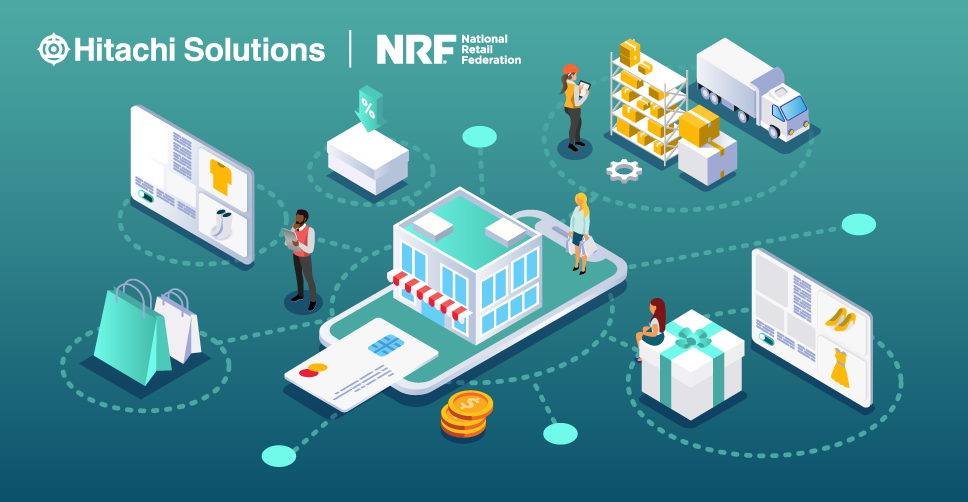

Maximizing the Retail Supply Chain
How to revolutionize your brand approach to create a truly frictionless retail customer experience
Download the WhitepaperAfter a two-year break, the National Retail Federation’s (NRF) Big Show returned to New York this month radiating energy along with a bit of tempered optimism for 2023. Companies are refocusing on the customer to retain and gain market share and to respond to economic headwinds. They realize they can’t stop innovating at the pandemic pace, but agree they need to be pragmatic about the investments they make.
What’s new and exciting is how organizations are using technology — both existing and evolving — to do it. Areas generating the biggest buzz include:
- Digital in-store experience
- Fine-tuning supply chain optimization
- Insightful tools for the front-line worker
- Sustainability
Digital in-store experience
Brick-and-mortar stores aren’t going away, and it’s more important than ever that consumers view the in-store experience as a core part of the overall buying journey — even when the transaction may ultimately be executed online.
Hence, the focus is on how to bring digital experiences into the physical store or the merging of physical space with the digital world. This integration of physical and digital — being coined as the phygital — signifies a major evolution in customer experience and is gaining importance in companies’ brand strategies.
We could call it the next stage of the omnichannel concept, unifying the customer journey across various physical and digital touchpoints. The most common example is probably BOPIS (buy online for in-store pickup). Other exciting options include:
- Grab-and-go stores
- Cashier-less, self-service checkout
- Interactive digital product displays to augment the product experience
Before diving in headfirst, companies should know what kind of experiences customers want, and how “phygital” can address those needs, wants, and motivations. By gaining that understanding first, you’ll have a better chance of success.
Fine-tuning supply chain optimization
Achieving endless aisle merchandise availability remains critical to retailers’ success. Thus, companies continue investing in technology to refine their supply chain to manage stocking levels while minimizing customer churn. In one of the Microsoft sessions at the big show, speakers shared that one of their largest retail customers found that if an item was out of stock on two separate visits, the customer was effectively lost.
On the warehousing side, software and robotics provide a bridge to help modernize facilities. Robotic solutions can power the movement of inventory and automate fulfillment and replenishment. And smaller robotics are being considered to support dark stores and drive more optimized fulfillment of last mile orders.
Artificial Intelligence (AI) and machine learning (ML) were highlighted again this year as tools that will provide deeper insights into all areas of the supply chain. This will help ensure retailers and brands have the insight they need to make proactive decisions on how to minimize disruptions and stock-outs.
Insightful tools for front-line workers
The workforce (store associate, warehouse worker, server) experience is catching up to the human experience – meaning the technologies we use in our everyday lives are becoming tools we will use on the job. IDC’s findings from one of its latest retail studies show 75 percent of retailers plan to double their investment in devices for their workforce.
This could include arming associates on the sales floor with digital devices and tools to better help customers find what they need, offering shoppers product recommendations on the next product to buy, and helping streamline the checkout process.
Microsoft had two big announcements at NRF. Both solutions are designed to super-charge retail front-line workers, making it easier for them to manage their schedules, complete tasks, locate merchandise for customers, and reduce friction in the store pickup process. The capabilities are provided through a low-code environment, making it easier for companies to be agile in building and adopting workforce tools in a changing economy.
The first solution is called Store Operations Assist. It allows real-time collaboration and increases front-line productivity so store associates have more time to serve customers. The second solution, Intelligent Stores, brings e-commerce analytics into physical stores. As adoption grows, the hope is autonomous, AI-embedded retail will become commonplace, allowing every frontline worker to be an expert.
Sustainability
It was evident throughout the show that sustainability is a focus everywhere. From customer-facing applications to daily operations, companies are prioritizing sustainability as part of their enterprise strategy and attempting to integrate awareness and purchase options in their digital transformation efforts.
Many eco-conscious consumers are vocal about wanting to make sustainable choices while shopping but don’t find it easy to do so. Thus, retailers are striving to highlight sustainability to increase awareness of product choices and to create new and more accessible ways for consumers to participate — for example, offering rebates or incentives for sustainable purchases.
Let’s talk
Retailers are in the convenience business and constantly face pressure to provide customers with a frictionless and complete buying experience, all while tailoring that experience to the interest and needs of the individual. At Hitachi Solutions, we’ve been helping retailers for years in their efforts to modernize systems, create differentiated experiences, develop more successful marketing insights, and gain market share across all channels and customers. If you have these needs or want to chat about the future technology can play in your company’s strategies, reach out today!


